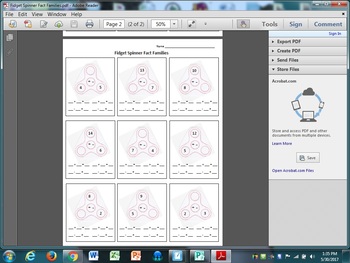Fidget Spinner Fact Families Worksheet
Ryan Omlie
10 Followers
Grade Levels
1st - 4th
Subjects
Resource Type
Standards
CCSS1.NBT.C.4
CCSS2.NBT.B.5
CCSS2.OA.B.2
CCSS3.OA.A.4
CCSS3.OA.B.5
Formats Included
- Publisher files
Pages
2 pages
Ryan Omlie
10 Followers
Description
This worksheet helps students practice fact families for multiplication and division or addition and subtraction. It motivates the students by organizing the fact families using fidget spinner clipart. The worksheets are editable using Microsoft Publisher so you can change the numbers and use as many times as you want.
Total Pages
2 pages
Answer Key
N/A
Teaching Duration
N/A
Last updated May 30th, 2017
Report this resource to TPT
Reported resources will be reviewed by our team. Report this resource to let us know if this resource violates TPT’s content guidelines.
Standards
to see state-specific standards (only available in the US).
CCSS1.NBT.C.4
Add within 100, including adding a two-digit number and a one-digit number, and adding a two-digit number and a multiple of 10, using concrete models or drawings and strategies based on place value, properties of operations, and/or the relationship between addition and subtraction; relate the strategy to a written method and explain the reasoning used. Understand that in adding two-digit numbers, one adds tens and tens, ones and ones; and sometimes it is necessary to compose a ten.
CCSS2.NBT.B.5
Fluently add and subtract within 100 using strategies based on place value, properties of operations, and/or the relationship between addition and subtraction.
CCSS2.OA.B.2
Fluently add and subtract within 20 using mental strategies. By end of Grade 2, know from memory all sums of two one-digit numbers.
CCSS3.OA.A.4
Determine the unknown whole number in a multiplication or division equation relating three whole numbers. For example, determine the unknown number that makes the equation true in each of the equations 8 × ? = 48, 5 = __ ÷ 3, 6 × 6 = ?.
CCSS3.OA.B.5
Apply properties of operations as strategies to multiply and divide. Examples: If 6 × 4 = 24 is known, then 4 × 6 = 24 is also known. (Commutative property of multiplication.) 3 × 5 × 2 can be found by 3 × 5 = 15, then 15 × 2 = 30, or by 5 × 2 = 10, then 3 × 10 = 30. (Associative property of multiplication.) Knowing that 8 × 5 = 40 and 8 × 2 = 16, one can find 8 × 7 as 8 × (5 + 2) = (8 × 5) + (8 × 2) = 40 + 16 = 56. (Distributive property.)



